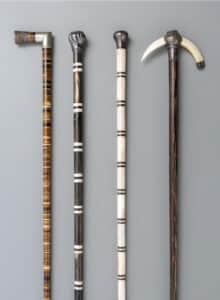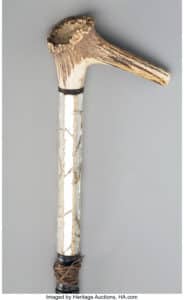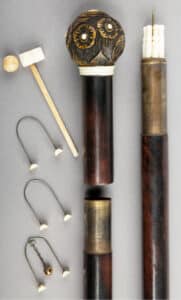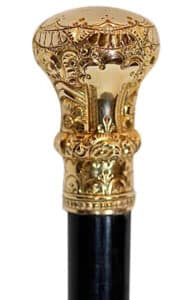By Melody Amsel-Arieli

silver knobs and ferrules, longest 36”. 19th century, realized $1,125 in 2018 photo: Heritage Auctions, HA.com
Nineteenth century walking sticks, also known as canes or handstaffs, apparently harken back to the humble shepherd staffs once used to herd sheep, traverse rough terrain, and fend off wild animals. Later ones, crafted to aid “persons of decayed constitutions,” often resembled these simple staffs of old.
When the art and craft produced more stylish ones—hand-carved from fine woods like ash, walnut, maple, mahogany, rosewood, oak, or cherry— these were designed to symbolize gentility, wealth, and power of the owner. Initially, these smart, slender sticks were bound with ribbons and dangled, hands-free, from waistcoat buttons. In time, attached to straps or thongs, they were dangled from wrists.
The Evolution of Walking Stick Style
Over time, additional changes occurred as these sticks were enhanced. Comfortable, compact, indented walking stick handles gave way to knobbed, rounded hollows housing whatever gentlemen might require while out and about. Pinches of snorting snuff, built-in pipes, lucifers (matches), and cigars to tiny vials of brandy, sweetened lemon juice to whet their whistle, or bracing nuggets of nutmeg or ginger were just a few of the eccentric requests for inclusion into one’s walking stick.
Some changes were apparently improvised on the spot. For example, a good-natured old gentleman somehow added a whistle to its top-knob to amuse grandchildren riding his walking stick like a hobby horse. This proved so popular that scores of fathers and grandfathers did the same.
These stylish accessories not only “swelled to the thickness of broomsticks with a nob of prodigious size,” but also grew in height.
By the 19th century, when dapper European and Americans were wont to flaunt their finery, walking sticks had become essential parts of a well-dressed gentleman’s attire. Different designs were deemed desirable for different occasions and for differing hours of the day. When leaving the house, cravats, neckties, and accessories including the walking stick were put together to attract the eye and reflect the strong sense of fashion and poise of the wearer.
A Man of the World

photo: Heritage Auctions, HA.com
As a result of the exploration of the natural wonders of the world, walking sticks continued to be refined and became available in a wide variety of styles and materials.
At formal events, members of the upper classes generally preferred “wearing” elegant models made of cane, bamboo, rattan palm, or carved from premium woods like ash, beech, blackthorn, crab, cherry, or maple, or oak. Others acquired ones made of exotic, natural materials like tortoiseshell, rhino horn, or ram’s horn. Their handles—indented, knob, pistol grip, crutch, or crook-shaped—were often made of luxurious gold, sterling silver, enamel, glass, alabaster, or ivory carved to resemble flowers, animals, human faces, grotesques, or mythical beasts. Yet many considered sticks encrusted with gems or trimmed with flashy mother-of-pearl, silk, or leather accents the most prestigious of all.
During the Industrial Revolution, when much of walking stick production became mechanized, demand also soared among the lower classes. In America, as in Europe, forests of low-cost walking sticks appeared, ranging from thick, cattle-driver cudgels to slender, delicate bamboo and gutta-percha “whiptails.”
Use of Walking Sticks Whilst Out and About
Most gentlemen employed their walking sticks prudently as they strolled about – navigating ditches, measuring the depth of puddles, “beheading” weeds, and extending their reach. Others, however, wielded them wildly, with no sense of propriety.
Many brandished their sticks willy-nilly in all directions or twirled them round and round by ribbon, thong, or strap. Others dragged them at their heels or, shouldering them like bayonets, imperiled all who followed in their footsteps. Some, like turnstiles, toted sticks horizontally at their armpits or waist, impeding passersby both coming and going. Others utilized sticks to dispatch opponents, clear their way through crowds or, in the midst of an argument, pointedly punctuate strong points. The infirm and weary, on the other hand, peered down before each step, then set their sticks down decisively lest they land on apple cores, orange peels, or other slippery stuff.
Customizing All Parts

Walking stick shafts, as their knob handles, were often hollowed out as well. Many contained indispensable “tools of the trade ” like doctors’ pill dispensers, architects’ straight edges, scholars’ spectacles, or cidermakers’ siphons, spouts, and apple-pressing rods.
Contents of other hollow shafts reflected various gentlemanly passions or pastimes. Some held telescopes, periscopes, or barometers. Others held coin scales, art supplies, harmonicas, violins, fishing rods, or devices which, when unscrewed, reconfigured into spinning mirrors – likely used to attract birds and insects.
Walking stick shafts containing unusual items, like croquet sets (complete with a ball, mallet, six stakes, and three wickets) or jump ropes (with silver repoussé handles), evoke long past times of frolic and laughter. Yet when treasures like these fell from use, they were sometimes passed on to children as playthings. Discovering one complete and intact with all its accoutremonts is not only exciting but rare.
Nineteenth century Americans found “gadget” walking sticks (also known as “system” sticks) particularly pleasing. Through finely crafted mechanisms within their shafts and handles, they cleverly fulfilled dual or hidden purposes. Some, designed for butter or grain dealers, for example, featured handles which operated scoops at their ends. Some ingeniously unfolded into fiddles, music stands, preachers’ lecterns, or tiny gaming tables. Other sticks cunningly concealed useful weapons like firearms, daggers, spring-driven blades, crossbows, or even mace balls.
Collecting Handstaffs
Many collect 19th century walking sticks because they are appealing, readily available, and easily stored. Some prefer pieces wrought from a particular material or made in a particular place. Others assemble themed collections.
Sticks traced to famed soldiers or leaders are perennially popular. American presidents, such as George Washington and Abraham Lincoln, for example, apparently owned several. So did Ulysses S. Grant. Judging by the number of surviving sticks featuring knobs bearing his image, so did scores of his admirers.

Canes carved with names of their owners, like Dr. Samuel H. Caldwell, a Confederate Surgeon under General Nathan Bedford Forrest, are also highly prized. So are opulent, gold-tipped presentation walking sticks, some awarded to anonymous civic servants, others inscribed to influential leaders like John F. McCauley who, in 1856, assumed management of San Quentin Prison.
Nautical-themed handstaffs, perhaps carved during lengthy Massachusetts or Maine whaling expeditions, are also highly collectible. Wooden ones often feature carved, high-relief images of sea creatures surrounded by intricately worked sailing knots. Others, utilizing the materials closest at hand, were imaginatively fashioned from narwhal tusk, baleen, whalebone, or whale teeth.
Folk art-type walking sticks, which were typically whittled from tree branches, were favored by scores of 19th century American farmers, woodsmen, hikers, and hunters. Each, a world unto itself, expresses the creativity and personality of a single individual – its creator. Roughly carved branches often feature geometric patterns formed by retaining bits of their original bark. Thick, undulating ones, if topped by carved heads with gaping mouths and malevolent red-paint eyes, resemble gargantuan snakes from tip to toe. Naturally gnarled, bumpy burls often inspire humorous, high-relief carved images. Other sticks, more artistic, feature skillful carvings or twist the length of their shafts.
Today’s Market
American 19th century walking sticks currently command between several hundred and several thousand dollars each. Those combining premium materials, like gold with porcelain or jade with rubies, are typically most expensive. Craftsmanship, ornamentation, uniqueness, and condition also affect their worth. Yet collectors may be willing to overlook minor flaws, like chips, cracks, or discolorations, regarding exceptionally rare, attractive, or personally appealing pieces.
Discovering (or imagining) the history of a walking stick is a huge part of that appeal. So is holding, handling, and trying it – retracing the steps of a 19th century American gentleman.





Related posts: